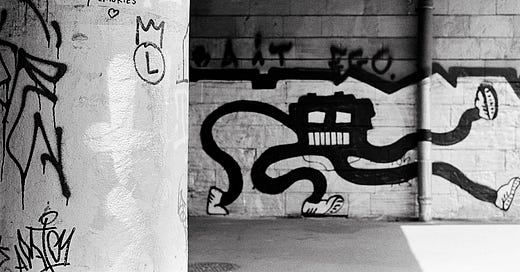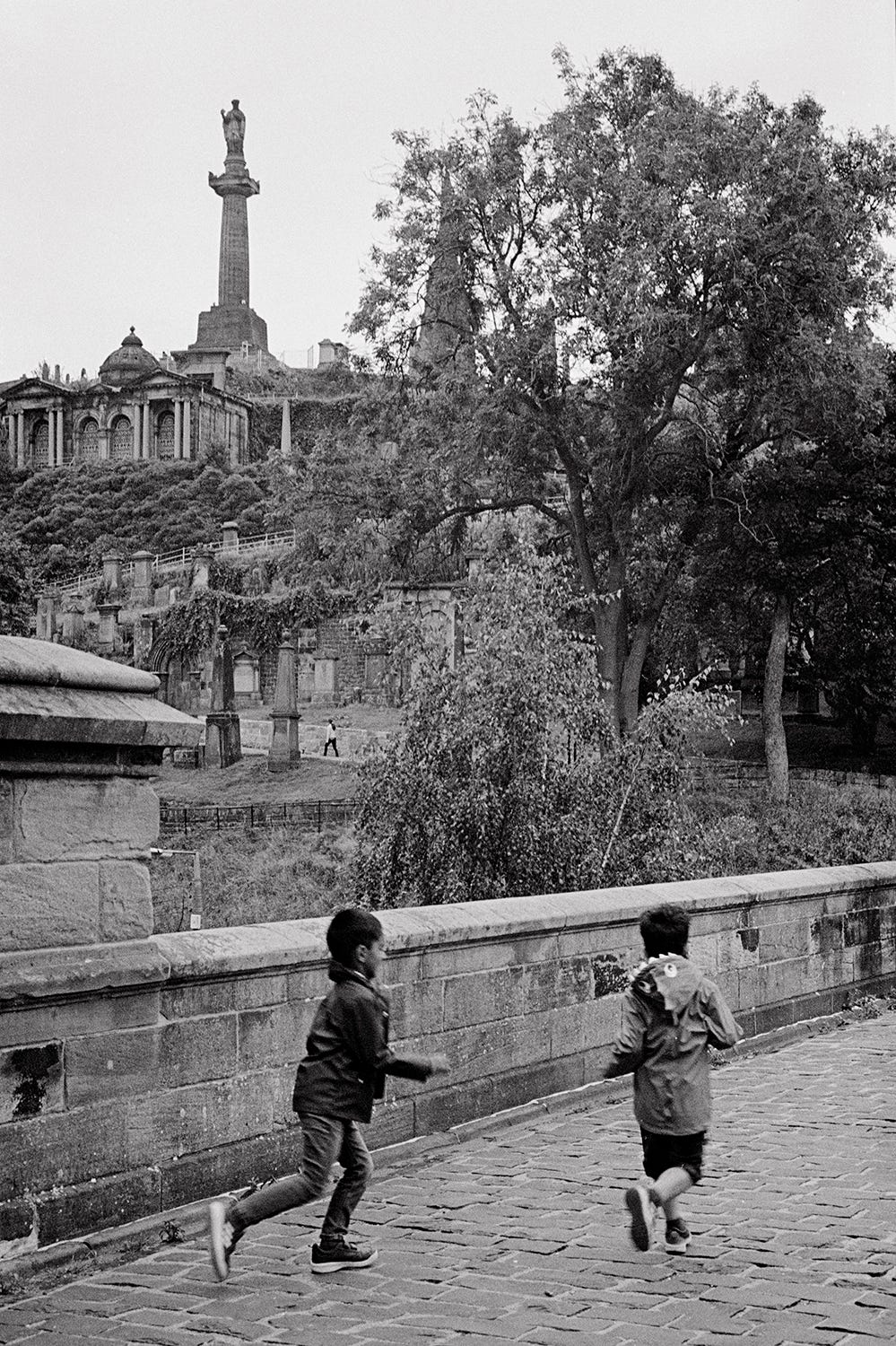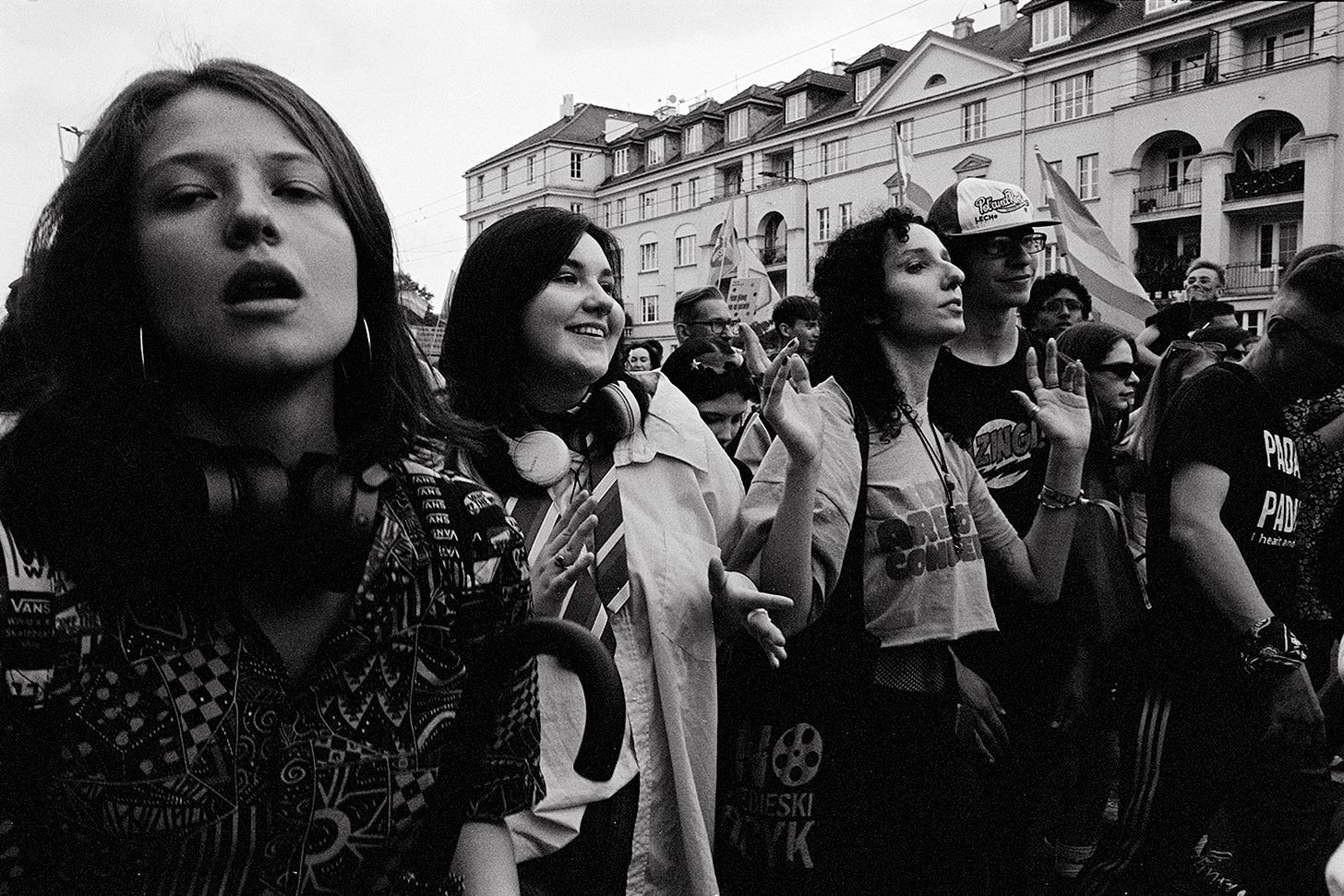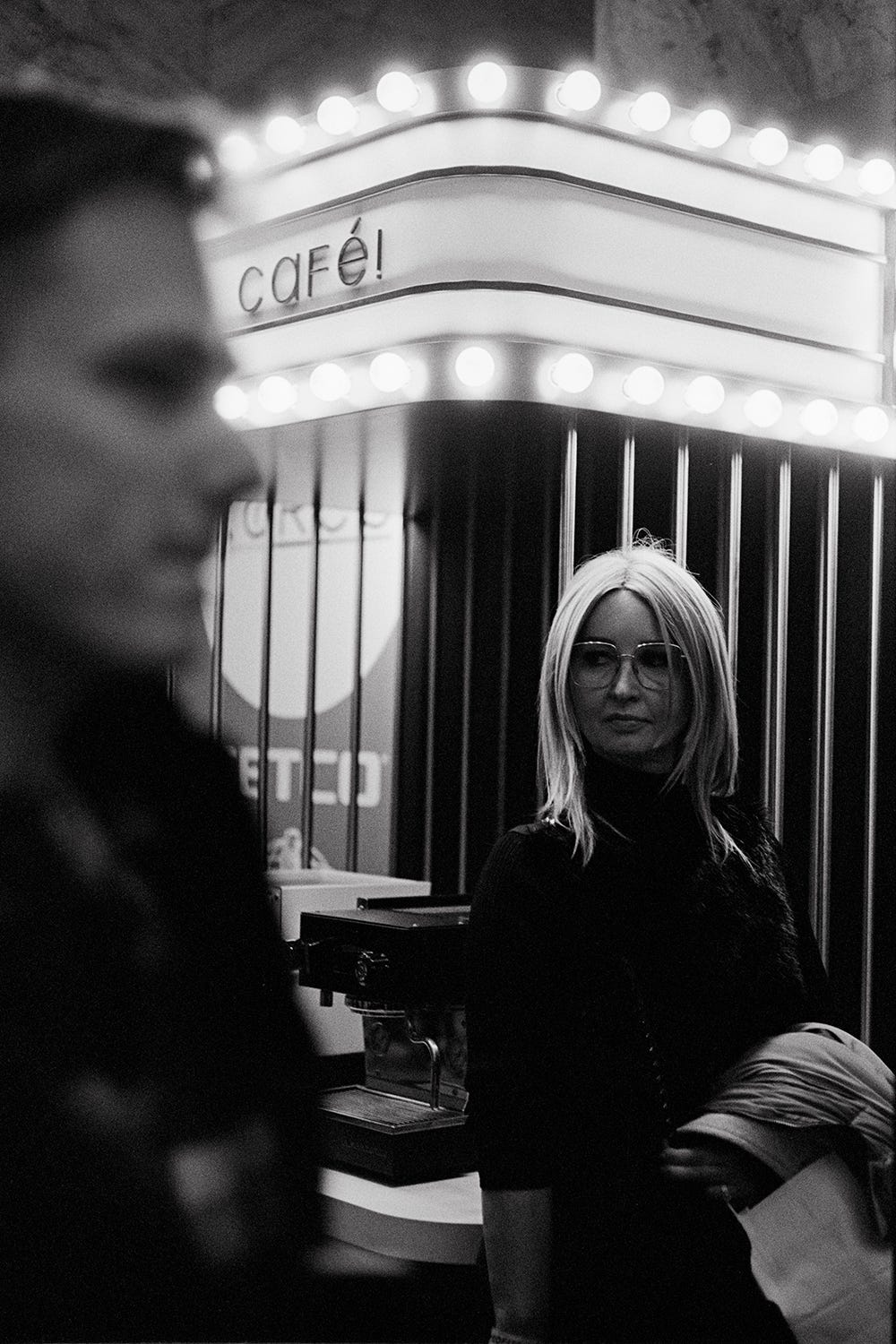Issue 09: Film for the Future
Or: Street Photography, Collective Memory, and Nostalgia
Someone sang a song and I sang along / Cause I knew the words from my childhood
- Nobody's Empire - Belle and Sebastian
It was a photograph of a McDonalds. An enormous blow-up Ronald sitting outside like some inebriated fairytale troll fallen on hard times. Seen through critical eyes it was a notable if not great photograph, and yet there it hung, among many others of varying quality, on the walls of Muzeum Warszawy in Warsaw. This was an exhibition of street, documentary, and vernacular photography from the 1990s and the scene in this unassuming photograph, despite seeming commonplace now, was then unprecedented. In 1992, 3 years after the fall of communism, this was the opening of the first McDonalds in Poland. The symbolism spills from the frame.
I enjoyed my slow drift through the exhibition though the pictures offered a spark of something more to my partner's Polish eyes. Recollections of long-removed kiosks, fond memories of trundling old trams, wistful smiles at the nascent western fashion replacing outmoded communist era clothing. I was curious if Marta would share the same experience of photographs of Glasgow. She found Depardon's photographs of the city absorbing, not least because, unlike most of the photographs I show her, they were in colour. It was, however, my childhood memories of the city in the 1980s that tinged my own reading of the photographs with that dewy morning mist of a feeling, nostalgia.
Nostalgia and Historical Memory
Memory of past places, events, and experiences build a shared story within a group, whether a circle of friends, or a nation. We remember, and share those memories with others and in doing so an interpretation of local, national, or international history is formed, shaping our identity, culture, and values. Seen through the mirror of nostalgia, collective memory can be capricious. Interpretations are subjective. A place I remember with fondness, Marta may have had a contrasting experience.
As a Scottish emigrant to Poland, I'm a dear pal to Johaness Hofer's 17th century definition of nostalgia. As Clay Routledge describes, it is the pain caused by the desire to return to one’s native land. I do often find myself misty-eyed with romantic notions of Scotland: Lochs, hills, music, and the fruity chemistry of my beloved Irn-Bru. In time, what is meant by nostalgia has evolved and been reshaped into what research has shown is a concept, universally understood. In her 1987 essay, The Psychology of Nostalgia, Hatice Aydan Kaplan called nostalgia a saddening farewell to childhood [...] or a longing for a past forever lost. Nostalgia is a fond memory tinged with longing of a time or place gone by. It is often sensory. When we hear, smell, taste, or see something that is a reminder of the past, yearning nostalgic reverie may follow.
Collective Memory
Like the plastic arts that came before, the video that followed, or the current influencer-led content boom of social media, street photography has played a significant role in shaping collective memory and our cultural identity. It continues to do so. By capturing life happening around them, sometimes by design and often by the way, the photographer documents their contemporaneous world.
Street photography teaches us how to read and understand our recent cultural history. To the photographer, the picture illustrates the present and to the reader, it represents symbols of the past. Fashion, transport, technology, signage, and the urban landscape caught in the periphery of 1/125th of a second are all emblematic of a shared history in the public space.
Urban spaces brim with political and social meaning. In Depardon's work, old shop signage, derelict areas, and empty cans of Tennent's place the readers in the grim poverty of early Thatcherite Glasgow. Behind the moments captured in Martin Parr's transcendent work, The Last Resort, the symbols of haircuts, old cars, and swimsuits evoke memories of working class seaside summer holidays later in that same decade.
Social Change and Cultural Shifts
In the exhibition in Warsaw, respected names such as Niedenthal, Hartwig, and Musialówna are represented, however many of the pictures are from others less known. Street photographers were responsible for making a record of such a pivotal time in the country's history and have continued to do so, photographing parades, protests, and demonstrations in the last 10 years that will comprise collective memory in the decades to come.
One wonders what the next generation will make of the street photography made during our recent social upheaval. What will our photographs show of the empty streets, the masks and face-coverings, the doorstep support for the NHS, the conspiracy theory madness, and the long, slow return? What is certain is that street photography will be integral to the collective memory of that time and will inform future understanding of the global pandemic.
Of course, collective memory is not only formed by epochal events or national trauma. It can be slow, steady, and happen over a number of years. Bernice Abbott documented great social change in 1930s New York, and the great flaneur Eugène Atget photographed old Paris during its 20th century modernisation. Walking a city's streets is integral to record its changing nature. It shows, as Susan Sontag put it, how we, and the city age. Depardon photographed an uninviting Glasgow in 1980 and Elliott Erwitt photographed a more affluent yet still socially eccentric Glasgow in 2012. Both tell a story of Glasgows that I have experienced and both evoke very different feelings.
An Agent of Nostalgia
Our street photography is a time-capsule. With such facility for provoking collective memories of the past, it is no wonder street photography evokes such personal nostalgia in photographers and readers alike. It is subjective familiarity that connects readers to their past. The photography we make as street photographers today is not inherently nostalgic but as the years pass, elements found within the frame may prove nostalgic to readers. When friends or acquaintances doubt the ethical, or moral merit of street photography, I often frame it in this way. Those sepia-tinged Facebook posts they like of Lost Glasgow, or the Instagram account of London in the 1960s? In 30 or 40 years, online denizens may look back on our photography with that same warm hazy glow.
In Craig Semetko's book, Unposed, there is a photograph of 2 women chatting, sitting on a wall in front of a street food vendor as others queue for food. Unremarkable, you may think, save for the heads of the couple, each shrouded in a large paper eyeball. A wry, comic image that evokes considerable nostalgia in me. I recognise Edinburgh, immediately. This photograph was taken at the Edinburgh Festival in 2005, 1 year before I made my first tentative photographic steps at the same festival and I remember that very street food van. I know that wall. Somewhere, on a long-forgotten folder on my hard drive, I have a similar photograph, without the eyeballs, of course. Nostalgia is subjective and different elements evoke the feeling based on our backgrounds and experiences, however, street photography preserves the essence of generations past, much that is universal to all.
Footsteps
In 1951, Cartier-Bresson stood on the Pont des Arts and took a superlative picture of Ile de la Cité. It is one of my favourite photographs. In 2009, I stood in his footsteps to take the same picture, doing so again last year. I looked on Cartier-Bresson's Ile de la Cité with such nostalgia long before I ever stood on the bridge. Feelings of nostalgia can arise for a time long before you were born, or a place you have never visited. Exposure to books, movies, television, or music can synthesise experiences that in turn evoke nostalgia from elements of street photography. Without being aware, my affection for Paris may have grown through the music of Messiaen, the cinema of La Nouvelle Vague, or - more likely - Hugo's Les Miserables.
Street photography itself can precipitate wistful nostalgia from other street photography. Cartier-Bresson's photographs of Paris seared themselves so completely into my memory that the more contemporary Parisian photographs of Richard Kalvar feel like a warm, affectionate greeting from an old friend.
The Archive
To inform collective memory, or indeed inspire a sense of nostalgia, the photography has to be seen, and there are many organisations worldwide dedicated to preserving historical street photography. Much of it found in well-thumbed books in the photography sections of book shops or libraries are from the masters. One doesn't need to travel far to find the books of Cartier-Bresson, Winogrand, Erwitt, et al. These are only a fraction of the street photographers available to readers with the will to find more. In Scotland, for instance, there is the National Library of Scotland's photographic archive, the British National Archive's collection, and the National Museum of Scotland's Scottish Life Archive. Widening the scope to Britain as a whole, and online, there is the treasure trove that is the British Cultural Archive.
Modern art galleries and photographic institutes around the world, including MoMA in New York, The Met, and ICP have extensive street photography collections to view, while agencies such as Magnum keep comprehensive archives of their members' work. Photographers themselves often found organisations to archive their work and support others: The Martin Parr Foundation, and Fondation Henri Cartier-Bresson are but 2.
Retromania: New Nostalgia
In Simon Reynolds book, Retromania, he explores our obsession with all things retro through the lens of music and the wider realm of pop-culture. In reading this book, I kept returning to thoughts of the last decade of visual social media. Before Instagram, there was an early mobile app named Hipstamatic. A camera app with film-like filters to give your snapshots a retro look. Hipstamatic fell down as unlike Instagram, there was no timeline or community, and in a time before the in-app purchase boom, the user had to pay for packs of filters. The then trendy faux-film aesthetic exploded into the zeitgeist and took Instagram to the stratosphere.
With the decline of Instagram, the faux-film aesthetic has found a new, surprising outlet. In a move towards the nostalgic, younger photographers are stepping away from digital and loading second-hand 35mm cameras, bringing some intriguing new perspectives to street photography on film. As maligned as it is, one wonders how much we have to thank Instagram for that.
Street photography and it's relationship with nostalgia, what do you think? Which street photographers evoke nostalgia in you? Let me know in the comments.
Digest, July 2023
A discussion of photo books that arose on Substack Notes lit a fire under me. I began to consider what would be required reading for a street photographer. This first article will no doubt be the first of many.
With no Shoot It With film article this month, I wrote on my blog about the value of returning to past work, uncovering hidden gems, and learning from past mistakes.
Following on from last month’s photo essays on Corpus Christi and the 4th June March for Democracy in Warsaw, here is a photo essay on this year’s March for Equality in the Polish capital.
For its sophomore outing, my Top 5s series moves from Liverpool to Glasgow as I choose my 5 best sketches from Brian Limond, AKA Limmy.
I return to my semi-regular series, continuing to watch the 100 greatest British movies of the 20th century as chosen by the British Film Institute.
91: My Name is Joe | 90: Hope and Glory | 89: Fires Were Started
Some Photos
And Finally…
Stay tuned for the next Dispatches email coming on the 9th August.
If you’ve enjoyed issue number 9, I’d be very grateful if you could subscribe, share, and recommend it to any street photography-loving friends. It really does help more than you would think.
This newsletter is free to read, however, I've recently left corporate life and returned to school, so if you like what I do, please consider buying me a roll of film. You can do so by clicking here, or by aiming your camera at the QR code below.
I'm partial to some of that Tri-X 400 if you're asking. Thank you!














Very timely to read this post about street photography and nostalgia, Neil, as I’ve just received two big boxes of photos taken in my teens (which have been in storage at my Mum’s place for 20-odd years ago). I’m both excited and nervous to go through them all, but feeling inspired by your post to perhaps share some in a future issue of my own newsletter...
And thank you to @Charlene Storey for recommending this post. I’ve subscribed to read future ones.
Really enjoyed this exploration of street photography, Neil! Thanks for sharing. Loved the photos too. I've not done much with black and white lately but this post has really made me want to do it again! Gorgeous.